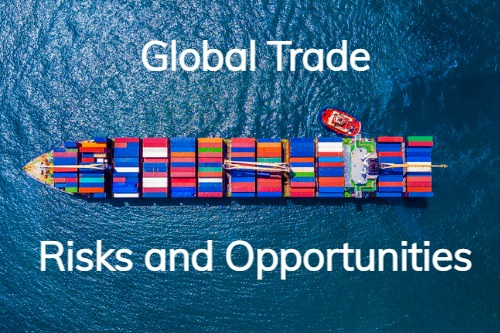QBE Insight: Global Trade – Risks and Opportunities

Authored by Peter Burton, QBE, Executive Director, International Markets
Global trade volumes saw the start of a good recovery in 2021 but the beginning of 2022 saw a dramatic turn for the worse. With global economic conditions tightening, understanding the changing landscape and the risks and opportunities that it presents will be important to succeeding in the upcoming years.
The shifting global landscape
Even before the global pandemic, geopolitical and demographic forces were working to upset the long-established model for global trading. Restrictions brought in during the crisis and the ongoing war in Ukraine have only served to accelerate this change.
The steady shift east in the global economic “centre of gravity” and the increasing power and sophistication of the growing economies in Asia is well documented. These countries are no longer just providers of low-cost goods and components, but instead world leaders in hi-tech fields such as telecommunications and pharmaceuticals with rapidly growing middle classes. This shift is expected to accelerate with these countries predicted to out strip the recovery of the more established G7 countries.
In addition to the terrible humanitarian and wider economic impacts of the war in Ukraine, it has also impacted traditional trading relationships. There has been clear polarisation of the western and Russian trading blocs, but also the emergence of a less aligned group that have continued to trade in both camps. The largest of this group, China, saw overall foreign trade increase 10.1% from January to April 2022 reaching 1.98 trillion USD with a widening of the trade surplus with the US and a 25% increase in trade with Russia.
But, with concerns in the western trade bloc about China’s own expansionist ambitions this trend could change. Navigating and adapting to this uncertain landscape, particularly across the less aligned countries, will be critical to succeeding over the upcoming years.
The rise of national self-reliance?
A popular topic of discussion during the pandemic was building greater regional and national self-reliance through re-shoring or near shoring supply chains.
While the continued focus on supply chain resilience and increased transportation costs will keep this topic front of mind, there is little indication yet that the short term rise in “Trade Independence” observed in 2020 has taken hold as a long-term global trend.
But there has been a rise in internal consumption and trade within established trading blocs in several key areas, (though this trend is far from uniform). More recently, this has been accelerated by the impact of the war on energy sources and certain commodities. But finding regional substitutes will not happen overnight.
Regional Self Reliance and Energy security: Post-pandemic price surges and the war in Ukraine have underlined the need for more resilient and reliable access to affordable energy less susceptible to supply chain or geopolitical disruption. As many countries now get to grips with this challenge at a national level, so too are many firms are looking to improve their own energy security through solutions ranging from improved energy efficiency, renewable generation and storage and longer-term power purchase agreements.
The beginning of 2022 reminded us that changes in geopolitical relationships can happen unexpectedly quickly and have long lasting economic impacts.
Geopolitics continue to be the wild card
If this had been written in late 2021, one could have been tempted to predict a more stable era of geopolitical relationships. A more measured relationship between the US and China and an acceptance of the post Brexit reality closer to home pointed towards predictability if not stability in global relationships. The beginning of 2022 reminded us that changes in geopolitical relationships can happen unexpectedly quickly and have long lasting economic impacts. Monitoring the position of the less aligned countries, particularly China, will be important in understanding the path ahead.
Supply Chain Disruption
Supply chain issues continue to impact global trade flows. While initial issues with shipping and storage supply have started to subside the longer-term impact of elevated transportation costs have started to take hold. Rather than just a short-term reaction to the supply demand mismatch, this has been driven by sustained increases in fuel cost exacerbated by the war in Ukraine impacting the overall cost structure.
In addition to contributing to the cost of transporting goods, the war has also contributed to availability issues for several goods and raw materials. From neon used in microchip production to sunflower oil and wheat, all have been directly impacted by the war.
Public policy changes
As we begin to emerge from the pandemic the global economy is also likely to navigate several public policy transitions. Fiscal stimulus packages rolled out during the crisis are being phased out and moving towards greater fiscal restraint. In response to inflationary pressures countries are also beginning to raise interest rates which will have knock on effects throughout the economy. The combination of high inflation and lower growth limit the public policy options available, adding to future uncertainty. As this uncertainty increases, we can also expect a tightening of credit conditions which could further impact the recovery and ultimately trading relationships,
How do I prepare myself for the future?
While most sources indicate we have now exceeded or are close to exceeding pre-pandemic levels of global trade, many are predicting a significant slowdown for the remainder of 2022 and 2023. As before the crisis (and underlined during it!) understanding and addressing this extended uncertainty will be critical to addressing any risks and opportunities that emerge.
Actively monitor changes in the market
While it is a truism to say that you need to understand your markets to see the opportunities, uncertainty requires a disciplined approach to uncovering and addressing any changes that surface. In addition to the approaches to understanding uncertainty we outlined in our article Planning and executing in periods of uncertainty, firms should also keep a close eye on the changing geopolitical landscape and how it is impacting their customers and suppliers.
Understand and build links to new markets
The pandemic highlighted the need to continually find new ways to connect with customers. This was equally true with retail businesses rolling out click and collect options as it was with B2B sales forces rolling out virtual meetings. Times of economic uncertainty are no different. More thoughts on building a resilient sales organisation able to connect with a wide range of markets and customers is included.
Addressing opportunities closer to home
While it is too early to predict a wholesale retrenchment of global value chains, four factors may mean new opportunities closer to home. These factors include the prospect of an extended period of high transport costs, the desire to build regional supply chain resilience, the desire to reduce the overall carbon footprint of the supply chain and cost equalisation driven by digital investments.
Doubling down on digital infrastructure
The pandemic underlined the importance of a solid digital infrastructure in building business agility. Far from leaping to every new “shiny” new digital trend, this means ensuring the digital basics are addressed in your key sales and distribution processes and you can adapt to changing market conditions.
A focus on sustainability
With the focus of everyone from consumers to capital markets focusing on sustainability, ensuring a clear alignment with sustainability goals will likely be a prerequisite to many trading relationships (and good economic sense with the current situation in the energy markets). In addition, the adoption issues in our transition to sustainable energy sources will inevitably provide significant growth opportunities for those firms that are able to fill the gap.
About QBE
QBE European Operations is part of QBE Insurance Group, one of the world’s leading international insurers and reinsurers and Standard & Poor’s A+ rated. Listed on the Australian Securities Exchange, QBE’s gross written premium for the year ended 31 December 2018 was US$13.7 billion.
As a business insurance specialist, QBE European Operations offers a range of insurance products from the standard suite of property, casualty and motor to the specialist financial lines, marine and energy. All are tailored to the individual needs of our small, medium and large client base.
We understand the crucial role that effective risk management plays in all organisations and work hard to understand our clients’ businesses so that we offer insurance solutions that meet their needs – from complex programmes to simpler e-trading solutions – and support them in minimising their risk exposures. Our expert risk management and rehabilitation practitioners focus on helping clients improve their risk management so that they may benefit from a reduction in claims frequency and costs.

